Physical Address
304 North Cardinal St.
Dorchester Center, MA 02124
This chapter is intended to provide a working overview of the tumours and tumour-like nodular lesions that the pathologist will encounter with some frequency in everyday practice. The majority of these can be classified according to the putative cells of origin (hepatocytes, bile-duct epithelium and endothelium) from which they arise ( Table 11.1 ), and immunohistochemistry can often be used effectively to distinguish histogenesis. It is also germane to note that many liver tumours, both benign and malignant, now have known associations with genomic alterations that can be correlated with histologic features and are potentially useful in therapy ( Table 11.2 ). Neoplastic and nodular lesions of adults are covered first, followed by lesions in children and a section on cytopathological diagnosis. The reader is encouraged to consult the references and general reading list for additional details and coverage of some of the rarer tumours.
| Putative cell of origin | Benign | Malignant |
|---|---|---|
| Hepatocyte | Liver-cell adenoma MRN FNH NRH PNT |
Hepatocellular carcinoma Fibrolamellar carcinoma Hepatoblastoma |
| Bile-duct epithelium | Bile-duct adenoma Cystadenoma Adenofibroma |
Cholangiocarcinoma Cystadenocarcinoma |
| Mixed liver cell and bile-duct cell | Mesenchymal hamartoma | Combined hepatocellular cholangiocarcinoma |
| Endothelial cell | Haemangioma Infantile haemangioendothelioma ∗ |
Angiosarcoma Epithelioid haemangioendothelioma |
∗ Some cases may behave more aggressively and are capable of metastasis.
| Tumour | Genomic change (% of cases) |
|---|---|
| Hepatocellular carcinoma Fibrolamellar subtype |
TERT promoter mutations (60%) TP53 mutation (30%) WNT signalling ( CTNNB1 30%; AXIN1 10%) Chromatin remodelling ( ARID1A 10%; ARID2 5%) DNAJB1-PRKACA fusion |
| Cholangiocarcinoma | CDKN2A mutation (47%) KRAS mutation (22% intrahepatic; 42% perihilar and distal) IDH1/IDH2 mutation (25% intrahepatic) FGFR2 aberrations/rearrangements (10%–16% intrahepatic) HER2 amplification (11%–20% peripheral and distal; 4.8% intrahepatic ) |
| Hepatocellular adenoma | HNF1A inactivating mutation ( Steatotic adenoma ) β-Catenin activating mutation ( Atypical adenoma ) JAK/STAT pathway activation by somatic mutations ( inflammatory adenoma) :
No known genomic change ( Unclassified adenoma ; 10% of cases) |
| Hepatoblastoma | WNT signalling ( CTNNB1/APC ) with further subgroups:
|
| Mesenchymal hamartoma | C19g13.4 translocations |
Hepatocellular adenomas (HCAs) are solitary or occasionally multiple tumours composed of hepatocytes. Macroscopically they are well defined but often not encapsulated. The cells of the tumour closely resemble normal hepatocytes ( Fig. 11.1 ). Nuclei are small and regular and mitoses are almost never seen. These features are evident in fine-needle aspiration biopsies (FNABs). The cells are arranged in normal or thickened trabeculae interspersed with prominent arteries and thin-walled blood vessels. In adenomas, reticulin is normal or sometimes reduced, but extensive loss is in most cases confined to areas of necrosis or haemorrhage. The latter are characteristically found in adenomas in oral contraceptive users, and are responsible for pain and for the serious complication of haemoperitoneum. They probably also explain the fibrous scars which are sometimes found in the lesions. Regular septa, portal tracts and bile ducts are, however, absent; this distinguishes HCAs from both non-neoplastic liver and macroregenerative nodules (MRNs: large regenerative nodules) in cirrhosis and from focal nodular hyperplasia (FNH). Exceptions to this rule may occur in patients with multiple adenomas (adenomatosis ) where bile ducts can become entrapped within the lesions and in the inflammatory adenoma where focal ductular reaction is sometimes present (discussed later).
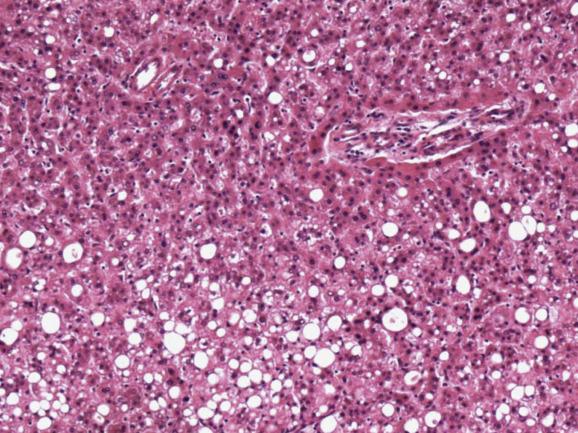
Adenomas may contain Dubin–Johnson-like pigment or show steatohepatitis with Mallory–Denk bodies. Non-necrotising granulomas within adenomas are also described.
Genetic–histological correlations have allowed subclassification of adenomas into several subtypes with distinctive immunohistochemical signatures ( Table 11.3 ). Approximately 30%–40% of adenomas show HNF-1α inactivating mutations, and these typically contain fat but show no cytological atypia ( Fig. 11.1 ). Activating β-catenin gene mutations are seen in some 10%–15% of adenomas with cytological atypia and acini, and these tumours are more likely to show transformation to hepatocellular carcinoma (HCC) and the chromosome gains and losses seen in HCC. Transformation is more common in men, and metabolic syndrome appears to be a risk factor. The third, and most common, subtype of adenoma is the inflammatory adenoma ( Fig. 11.2 ), which shows small amounts of connective tissue (pseudo-portal tracts) containing chronic inflammatory cell infiltrates (occasionally with adjacent ductular reaction) and/or sinusoidal dilatation. This subtype has been linked to IL6ST, STAT3 and GNAS -activating gene mutations and increased interleukin-6 signalling and represents some 40%–50% of adenomas. Individuals with inflammatory adenomas may have a systemic inflammatory, flu-like syndrome or, very rarely, develop systemic AA amyloidosis. The last HCA subtype accounts for 10% of adenomas, shows no unique histological or immunohistochemical features and is as yet genomically unclassified. The percentage of each adenoma subtype may vary depending on the population studied. Genomic data have also stratified adenomas according to specific features such as risk factors, bleeding and tendency towards malignant transformation.
| Lesion | Routine diagnostic features | Key immunohistochemical stain(s) |
|---|---|---|
| HCA | Benign-appearing hepatocytes Thickened cords and trabeculae Interspersed venules and arterioles Absence of bile ducts |
|
| HCA Subtype (%) | ||
| (Gene mutation) | ||
| Steatotic (30%–40%) ( HNF-1A inactivating mutation) |
Macrovesicular steatosis No cytological atypia |
LFABP: absent (compared to positive in normal liver) |
| β-catenin (10–15%) ( β-catenin activating mutation) |
Nuclear atypia Acini |
β-Catenin: nuclear and/or cytoplasmic positivity GS: diffuse, strong positivity |
| Inflammatory (40%–50%) [activating mutations in IL6ST (codes for gp130), STAT3 and GNAS] | Inflammation in pseudo-portal tracts Sinusoidal dilatation/ectasia may be present Focal ductular reaction may be present Steatosis sometimes present |
SAA: cytoplasmic positivity CRP: cytoplasmic positivity |
| Unclassified (10%) | No distinctive features | None identified |
| FNH | Central stellate scar Thick-walled artery within scar Ductular reaction at edge of scar Cirrhosis-like nodular parenchyma |
GS: Map-like broad fields of cytoplasmic positivity |
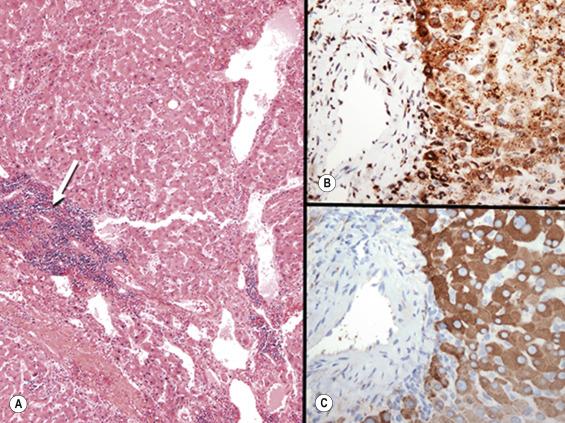
Distinguishing adenoma from either FNH or well-differentiated HCC can be diagnostically challenging. Targeted use of immunohistochemical stains may be necessary for such distinctions ( Table 11.3 ). In the case of adenoma versus HCC, loss of reticulin, nuclear atypia and mitotic activity and the presence of many acinar structures favour carcinoma. Immunohistochemical demonstration of nuclear and/or cytoplasmic β-catenin overexpression is often helpful evidence of transition to carcinoma, but is not invariably present. The presence of lipofuscin pigment within an adenoma ( pigmented hepatocellular adenoma; Fig. 11.3 ) also warrants close pathological attention, because this subgroup, especially in males, is at increased risk of atypia and malignancy. Pigmented adenomas may be found in all histological phenotypes of adenoma, with the HNF-1α subtype the most common. HCAs present diagnostic dilemmas, not only because of overlapping features in common with other benign hepatic lesions, but also because of overlapping features within subtypes of adenomas. Steatosis is not limited to the type 1, HNF1-α mutated adenoma, but may also be present in inflammatory adenomas. Ductular reaction is seen in FNH, but also, to a limited degree, in some inflammatory adenomas. Careful inspection of immunostains usually provides the critical distinction(s) between adenoma subtypes. In difficult cases where concern exists regarding transition to or documentation of HCC, immunostain results may be insufficient (as in some cases with β-catenin activation where there is variant glutamine synthetase (GS) expression), and genomic evaluation, particularly of exon 3 of the CTNNB1 gene, may clarify the diagnosis. Atypical histologic features such as focal reticulin loss, pseudoglands (acini) and other variant data may require a diagnosis of atypical hepatocellular neoplasm , or, for example in lesions that develop in androgen users, the diagnosis of HUMP (hepatocellular neoplasm of uncertain malignant potential ).
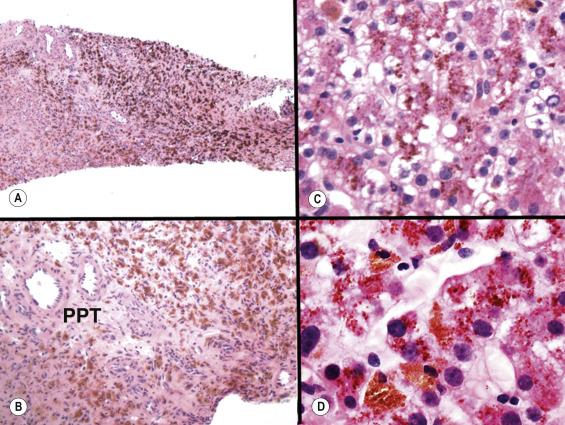
Most HCAs arise in women of child-bearing age, usually after prolonged use of oral contraceptives. Use of anabolic/androgenic steroids is a risk factor for both adenoma and HCC, particularly in Fanconi’s anaemia. Rarely, adenomas arise in chronic liver disease and cirrhosis, usually the inflammatory subtype. Adenomatosis , in which multiple tumours are seen throughout the liver, is much less common, is associated with HNF-1 α mutations and shows female predominance. A subgroup of these cases is familial and associated with diabetes. Adenomatosis is also seen in patients taking anabolic/androgenic steroids or in patients without risk factors. HCAs may also arise in patients with diabetes or type I glycogen storage disease (usually the inflammatory subtype ) and in children or young adults (see the ‘Neoplasms and nodules in children’ section). In older and elderly men, metabolic syndrome is of growing concern for the development of adenomas and possible evolution to HCC.
FNH is a fairly common lesion, seen in either sex and at any age. FNH is a reactive, hyperplastic response of polyclonal hepatocytes, fibrous stroma and bile ductules due to a putative pre-existing arterial malformation. FNH, unlike liver-cell adenoma, does not appear to be caused by oral contraceptives. Although oral contraceptives may cause an increase in size and vascularity, they do not appear to influence the number or size of these lesions. Bleeding and rupture are rare, as is recurrence after resection. Features of FNH and adenoma are only very occasionally seen in the same tumour, and the occurrence of the two lesions in the same liver may be coincidental. There may be multiple FNHs in the same patient, and such individuals often have other lesions, including vascular anomalies (hepatic haemangioma, telangiectasis of the brain, berry aneurysm, dysplastic systemic arteries, portal-vein atresia), central nervous system neoplasms (meningioma, astrocytoma) and hemihypertrophy.
Macroscopically, the nodules are well demarcated from the normal hepatic parenchyma. They are usually pale, and are dissected by fibrous septa into nodules, giving them an appearance very like that of cirrhosis. There may be a prominent central fibrous scar ( Fig. 11.4 ) with closely associated smooth-muscle actin immunostain-positive activated stellate cells. Histologically, the appearance is also very like that of inactive cirrhosis. The dense fibrous septa contain large thick-walled and sometimes narrowed arteries, as well as bile-duct-like structures probably derived from metaplastic liver-cell plates or from progenitor cells. Cytokeratin 7 immunostain highlights the bile ductular structures ( Fig. 11.5 ) and helps distinguish FNH from adenoma. The presence of bile-duct cells in fine-needle aspiration cytology of FNH is helpful in distinguishing this lesion from HCC. In radiologically guided needle biopsies, the pathologist should be made aware that a mass lesion is being sampled, because the proliferated bile-duct-like structures and reactive stroma may otherwise suggest the diagnosis of mechanical bile-duct obstruction ( Fig. 11.5 ).
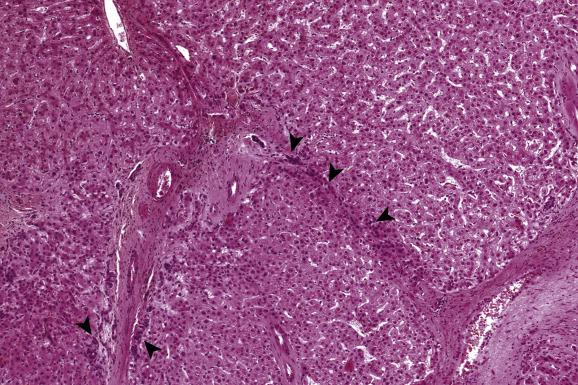
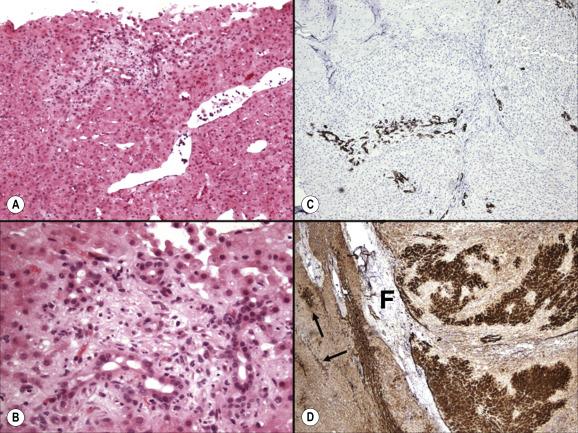
Lesions that grossly resemble FNH are also occasionally seen in Budd–Chiari syndrome. Microscopically, these masses show hyperplastic, regenerative nodules in combination with other features, including central scars and multiple arterial structures. Some vary histologically so as to suggest crossover lesions between large regenerative nodules, FNH and liver-cell adenoma. They appear to result from hyperarterialisation of regions of decreased hepatic venous blood flow. FNH is also seen after liver transplantation in allografts with vascular perfusion abnormalities.
FNH and adenoma are sometimes difficult to distinguish because of certain shared histological features, including the presence of isolated arterioles, thickened and nodular hepatocellular parenchyma, fibrosis and (in the inflammatory adenoma) inflammation and ductular reaction. The map-like staining pattern of broad islands of parenchyma in FNH seen with GS immunostain is helpful in confirming FNH ( Fig. 11.5 ).
In nodular regenerative hyperplasia (NRH) multiple hyperplastic parenchymal nodules with thickened liver-cell plates are seen but fibrosis is absent or slight ( Fig. 11.6 ). This distinguishes the lesion from cirrhosis. In some cases perisinusoidal fibrosis is found in the compressed liver tissue between nodules. Portal tracts may be found at the centres of the nodules, but this is not invariable. Diagnosis is often difficult in needle-biopsy specimens. The nodularity may be more clearly seen in reticulin preparations ( Fig. 11.7 ). A wedge liver biopsy may be required to establish the diagnosis and to exclude an important differential: incomplete septal cirrhosis ( Ch. 10 ).

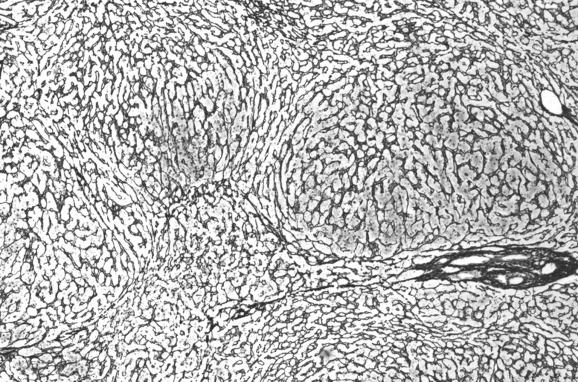
NRH is associated with a wide range of conditions, mainly rheumatic diseases, myeloproliferative disorders and chronic venous congestion. While uncommon, NRH is not rare and may represent from 4% to 15% of liver biopsy specimens obtained per annum in the evaluation of abnormal serum liver function tests. Patients with NRH may have received therapeutic drugs, including corticosteroids, anabolic steroids, oral contraceptives, antineoplastics, anticonvulsants and immunosuppressive agents. NRH has also been associated with HIV infection, the toxic-oil syndrome, Behçet’s disease, early histological stages of primary biliary cholangitis, coeliac disease with anticardiolipin antibodies, livers containing metastatic neuroendocrine tumours and non-cirrhotic livers in which HCC has developed. Some patients with NRH have portal hypertension, including (rarely) individuals with systemic mastocytosis. Serum alkaline phosphatase and γ-glutamyl transpeptidase levels may be elevated.
Wanless and co-workers have postulated that the basic lesion is portal venous thrombosis, leading to atrophy and compensatory hyperplasia. Arterial lesions, particularly arteriosclerosis of ageing, may also contribute to these changes. Sinusoidal injury per se is another possible cause. Drug-induced sinusoidal injury, as seen with NRH development after oxaliplatin administration, is an example. Disruption of fundamental cell biologic processes including telomere integrity and Notch1 signalling in the pathogenesis of NRH has received recent attention. Short telomere syndrome has been associated with NRH, dyskeratosis congenita and common variable immunodeficiency as well as with cryptogenic cirrhosis and idiopathic pulmonary fibrosis. Disruption of Notch1 signalling events involving endothelium in adult mice as well as Notch1 haploinsufficiency and downregulation also result in the development of NRH. Portal venous thrombosis has also been invoked in the pathogenesis of the rare partial nodular transformation , in which somewhat larger nodules are found, often localised to the perihilar region, where they may cause portal hypertension. NRH, FNH and partial nodular transformation share the common feature of liver-cell hyperplastic growth in the form of nodules; they have accordingly been grouped under the umbrella heading of ‘nodular transformation’ by Wanless.
Bile-duct adenomas are small, grey-white, usually subcapsular nodules measuring from 1 to 20 mm in diameter, which may represent hamartomatous peribiliary glands or reactive biliary lesions with features of foregut pyloric metaplasia, rather than a neoplasm. They are more often solitary than multiple. Histologically, they are composed of small, well-formed ducts embedded in a stroma of mature fibrous tissue which may contain chronic inflammatory cells, often densely aggregated at the periphery of the lesion ( Fig. 11.8 ). Their chief importance is that they may be mistaken for metastatic carcinoma, both macroscopically and microscopically. They differ from microhamartomas (von Meyenburg complexes) in that the ducts are smaller and more numerous, are usually not dilated and do not contain bile. Periodic acid–Schiff (PAS)-positive, diastase-resistant globules of α 1 -antitrypsin within the bile-duct epithelium of multiple adenomas were described in a patient with heterozygous α 1 -antitrypsin deficiency. The bile-duct adenoma should also be distinguished from the rare biliary adenofibroma , a much larger tumour composed of tubulocystic bile-duct structures with apocrine metaplasia and intraluminal bile embedded in fibrous stroma, resembling fibroadenoma of the breast.
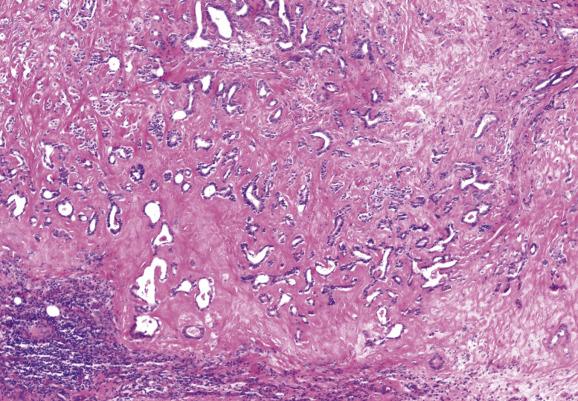
Biliary cystadenoma is a multilocular tumour, the cystic spaces of which contain mucoid fluid and are lined by columnar, mucin-secreting epithelium which may form papillary projections. A variant hepatobiliary mucinous cystic neoplasm with subepithelial ovarian-type stroma occurs in women. Malignant change is uncommon.
The cavernous haemangioma is the most common benign tumour of the liver, found incidentally at autopsy or operation and occasionally seen in biopsy material. A few reach a large and clinically significant size. As in other sites, the lesions are composed of endothelium-lined channels supported by a fibrous stroma ( Fig. 11.9 ). Lesional tissue sometimes extends irregularly into adjacent liver. Complications include thrombosis, sclerosis and calcification. Sclerosed haemangiomas may present diagnostic difficulties on needle biopsy and can be confused with healed granulomas, arteriovenous malformations or non-specific hepatic scars. Immunohistochemistry for endothelial cell markers (CD34 or CD31) usually allow a definitive diagnosis to be made ( Fig. 11.10 ). Spontaneous rupture is recorded but uncommon. A distinction should be made between cavernous haemangiomas and peliosis ( Ch. 12 ); the latter lacks the complete endothelial layer and fibrous trabeculae.
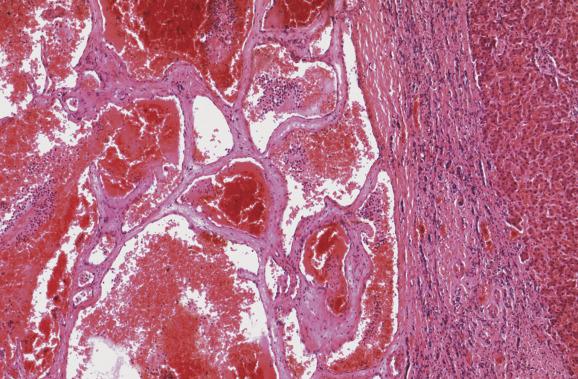
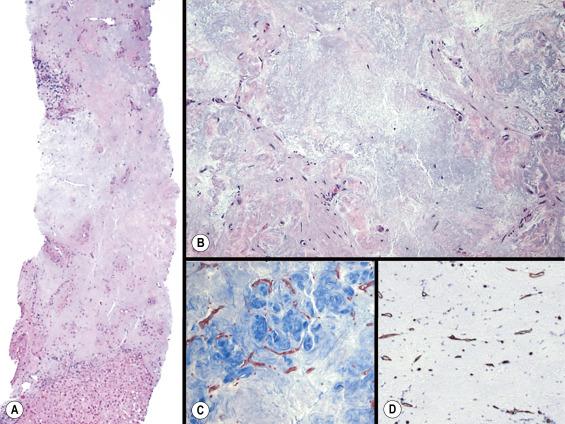
Rare, infiltrative vascular tumours in adults designated hepatic small vessel neoplasms have been described that appear to be low-grade, benign vascular tumours lined by endothelium with ovoid-to-plump nuclei and immunohistochemical positivity for CD34, CD31 and the proto-oncogene FLI-1. However, they demonstrate cellular proliferative indices >10% with Ki-67 immunostain and histologically show borders with lesional vessels infiltrating adjacent sinusoids. Lymphangioma of the liver has been reported as part of multiorgan lymphangiomatosis or as a solitary hepatic lesion, but is very rare. The endothelium-lined channels of this neoplasm are empty or contain lymph with occasional leukocytes. It should not be mistaken for mesenchymal hamartoma (see the ‘Neoplasms and nodules in children’ section).
Connective-tissue elements, adipocytes and smooth muscle of the liver, nerve sheaths of intrahepatic nerves and other mesenchymal cells may give rise to rare tumours, including lipomas, myelolipomas, angiomyelolipomas, schwannomas and neurofibromas, solitary fibrous tumours and chondromas. Angiomyolipomas resemble their more common renal counterparts and contain blood vessels, smooth muscle (myoid cells) and fat. These components allow subcategorisation into mixed, lipomatous, myomatous and angiomatous types, in decreasing order of frequency. Multiple tumours may be present. Muscle cells may be partly of epithelioid type, with finely granular eosinophilic cytoplasm and pleomorphic nuclei ( Fig. 11.11 ). These may be mistaken for hepatocytes or malignant cells, particularly in cases where the component of fat is minimal. Megakaryocytes and other bone marrow elements are commonly present. Positive HMB-45 immunostaining of the myoid cells is a major diagnostic feature. Pseudolipomas probably represent separated nodules of peritoneal fat which become embedded in the liver capsule.
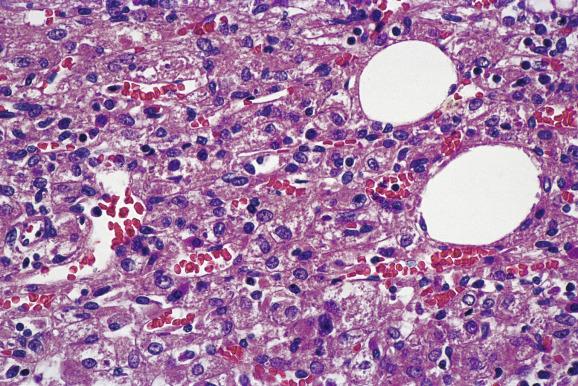
Lesions of inflammatory pseudotumour may be solitary or multiple and usually occur in young, male patients with constitutional symptoms, fever and weight loss. They may sometimes involve structures near the porta hepatis with resultant biliary problems or portal hypertension, or may mimic HCC. Surgical resection is the treatment of choice, when possible. The microscopic hallmark of inflammatory pseudotumour is the extensive polyclonal plasma-cell infiltrates which are intermixed with lymphocytes, eosinophils, foamy histiocytes and variable degrees of stromal proliferation, including spindle cells in bundles and whorls with associated fibrosis ( Fig. 11.12 ). Granulomas and partly obliterated blood vessels may be present. The lesion falls within a diagnostically controversial spectrum ranging from an inflammatory–reparative process (possibly infectious in aetiology) to a low-grade stromal malignancy termed inflammatory myofibroblastic tumour . Some have been thought to be follicular dendritic cell tumours related to Epstein–Barr virus infection. Immunostains are helpful to characterise individual cases. Among these, smooth-muscle actin will highlight the extent of the myofibroblastic component and activin-like kinase 1 expression in the spindle cells favours a diagnosis of inflammatory myofibroblastic tumour. Infrequently, such lesions are part of the spectrum of IgG4-related disease and show abundant IgG4-positive plasma cells with IgG4 immunostain.
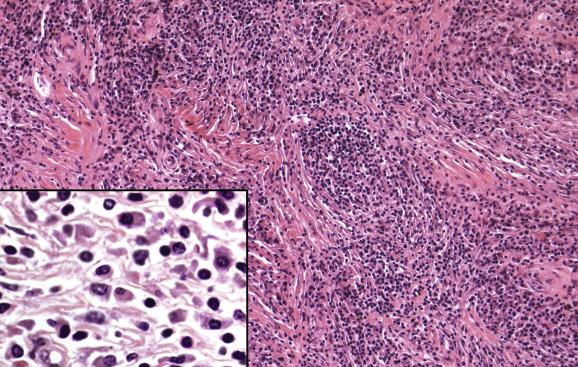
A number of hepatocellular changes and nodular lesions have been considered premalignant or precursors of HCC, and these are discussed in the following section. Despite refinements in the terminology of these lesions provided by panels of hepatic pathologists, the precise sequence of histological and molecular changes in the presumed multistep pathogenesis of HCC in humans has not been established. The importance of recognition of these worrisome lesions is based on the need for close patient surveillance and possible surgical resection (or liver transplantation) once they are identified pathologically. The presence of one or more of these lesions should be clearly stated in the pathologist’s report.
Non-neoplastic liver tissue may show varying degrees of liver-cell dysplasia (LCD) of either large- or small-cell type ( see Figs 10.8 and 10.9 ). Large-cell LCD (large-cell change) is the type most often observed and features cell and nuclear enlargement, nuclear pleomorphism, multinucleation and multiple nucleoli and increased nuclear staining ( see Figs 10.8 and 11.41 ). Its distribution is random within lobules or cirrhotic nodules and should be distinguished from the variations in nuclear morphology seen in perivenular hepatocytes with ageing, in the presence of cholestasis or in methotrexate therapy. This type of dysplasia was first associated with hepatitis B virus infection, cirrhosis and HCC and subsequently with a four- to fivefold increased risk of HCC in several studies. Affected cells are usually aneuploid and may have attendant chromosomal abnormalities. However, it has been considered merely an effect of cholestasis or a derangement in normal liver-cell polyploidisation and has not been proven to be a direct pathogenetic precursor lesion of HCC. Nevertheless, it is a strong independent risk factor for the development of HCC and thereby identifies patients requiring more diligent surveillance.
Small-cell LCD ( small-cell change ) is characterised by enlarged, hyperchromatic nuclei within small hepatocytes (increased nuclear–cytoplasmic ratio) arranged in crowded clusters ( see Figs 10.9 and 11.42 ). These foci show high cellular proliferation rates and an overall cytological resemblance to HCC, and may originate from progenitor cells. These features have lent support to small-cell LCD as a true precursor lesion that is subject to the later cellular events leading to the development of HCC.
Other cellular changes cited as indicators of premalignancy include intracytoplasmic Mallory bodies, irregular areas of regeneration showing hepatocyte glycogenosis, oncocytic change ( Ch. 9 ) or bulging nodularity, iron-negative foci in siderotic MRNs and ‘iron-free foci’ in livers of patients with hereditary haemochromatosis ; the last may show large-cell LCD. Clusters of large- or small-cell dysplastic hepatocytes less than 1 mm in diameter have been termed dysplastic foci by an international working party.
The MRN is an unusually large regenerative nodule measuring 0.8 cm or more in diameter which develops in cirrhosis or other chronic liver disease ( Fig. 11.13 ). MRNs are particularly common in macronodular cirrhosis. They may be paler or more bile-stained than the surrounding liver. The cirrhotic liver may harbour several MRNs, which may coexist with HCC elsewhere in the liver or may contain foci of carcinoma. Cirrhotic explant livers should be carefully examined for these lesions and for LCD.
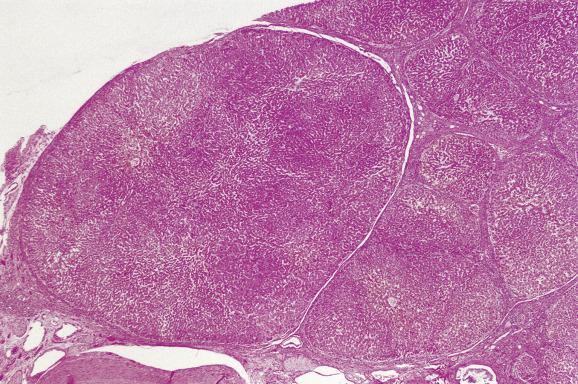
The MRN histologically shows hyperplastic liver parenchyma arranged in plates two or three cells thick, which is typical of cirrhosis. The nodule contains portal tracts and fibrous septa with bile ducts, hepatic arteries and portal-vein branches, and shows no cellular atypia or disorder in the liver-cell plate arrangement. Steatosis, haemosiderin, bile plugs and Mallory bodies may be present. The terms ‘adenomatous hyperplasia’, a former synonym of MRN, and subdivisions into MRN types I and II are not currently advocated for use.
The dysplastic nodule (borderline nodule) shows atypical architectural and/or cytological features that are not acceptable for a benign MRN, but which fall diagnostically short of frank HCC. Dysplastic nodules may show varying degrees of large- and small-cell LCD, increased cellularity and foci where the liver cords are less cohesive, focal loss of reticulin fibres or pseudoacini ( Fig. 11.14 ).
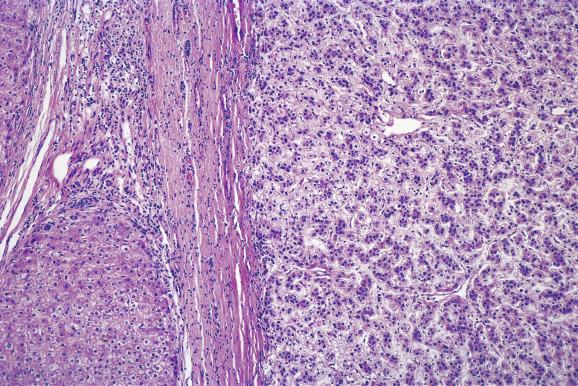
The major diagnostic concern is to distinguish MRNs and dysplastic nodules from HCC. Certain features seen in these nodules are associated with high risk of progression to carcinoma, including an increased ratio of nuclear density, clear-cell change, small-cell dysplasia and fatty change. Increased mitotic activity, loss of reticulin fibres, formation of broad trabeculae and an infiltrative margin are helpful evidence of carcinoma. Demonstration of clonality and loss of heterozygosity and increased cell proliferative indices are further supportive evidence of HCC.
HCC ranks sixth in incidence among malignant tumours worldwide and is the fourth most common cause of cancer-related death. Epidemiological and other studies of HCC have defined geographical variations in the incidence and prevalence of this tumour, as well as a multifactorial aetiology. Chronic necrosis and inflammation of the liver are important driving forces in the multistep process of hepatocarcinogenesis in the context of underlying risk factors such as hepatitis B and C viral infections, iron overload, aflatoxin exposure and the presence of fatty liver disease. At the molecular level, identification of genetic changes that control cell cycling and apoptosis, as well as oncogene expression, gene deletions and amplifications, mutation of tumour suppressor genes such as p53 , expression of vascular and cellular growth factors , somatic mutations in the TERT gene for telomerase reverse transcriptase proliferation of hepatic stem cells or their progeny constitute a large and growing literature on this subject.
The majority of HCCs develop in cirrhotic liver. The cause of the cirrhosis is usually known, even in many cases labelled as ‘cryptogenic’ where risk factors for non-alcoholic fatty liver disease ( Ch. 7 ) become apparent. The non-cirrhotic setting accounts for a substantial number of cases from North America and elsewhere, and can be seen in hepatitis B virus carriers or in those with suspected occult hepatitis B, in individuals infected with hepatitis C virus, and, increasingly, in non-alcoholic fatty liver disease with large-droplet fatty liver. In older and elderly non-cirrhotic men with metabolic syndrome and without cirrhosis, HCA may precede the development of HCC. HCC may even develop within ectopic liver. The cirrhosis associated with carcinoma is often macronodular in pattern, except for the micronodular cirrhosis seen in genetic haemochromatosis and chronic hepatitis C. The cirrhosis is usually inactive, although inflammation and necrosis may be seen near the tumour itself. Tumours may be multifocal. Intrahepatic tumour spread is both portal (via portal-vein branches) and lobular. Rarely, HCC may spontaneously regress. Following transplantation, cirrhotic explant livers require careful examination for small carcinomas and precursor lesions which are clinically undetected. Pathology reports on explants or partial resections with HCC should specify the number of lesions and their sizes, as well as the histological grade and evidence of vascular invasion, because these factors affect TNM staging and other prognostic classifications.
The outstanding histological features of HCC are the resemblance of the tumour cells to normal hepatocytes, and of their arrangement to the trabeculae of normal liver ( Fig. 11.15 ). However, the trabeculae are for the most part thicker, and reticulin is often scanty or even absent ( Fig. 11.16 ). This paucireticulin pattern is even helpful in FNABs (see the ‘Cytopathological diagnosis’ section). In exceptional cases where there may be an increase in reticulin, other histological features and/or the clinical behaviour of the tumour must be used as diagnostic criteria of malignancy. Rarely, the trabecular pattern and even bile production are mimicked by primary tumours (hepatoid carcinomas) of the stomach, ovary and other sites (see the ‘Metastatic tumour’ section). Between the tumour trabeculae in HCC there is a network of vascular channels lined by endothelium which is positive with immunostains for CD34, 184,185 factor VIII–related antigen and Ulex europaeus lectin. The endothelial lining of these channels is a particularly helpful diagnostic feature in fine-needle aspirates. The absence of portal tracts and a cohesive connective tissue framework in the tumour results in a characteristic fragmentation of needle biopsy specimens with separation of tumour trabeculae that is readily observed at low magnification ( Ch. 4 , Fig. 4.1 ). Although connective tissue stroma is uncommon except in fibrolamellar carcinoma (described later), focal areas of fibrosis may follow tumour necrosis. In addition, a small percentage of HCCs are scirrhous HCCs ( Fig. 11.17 ) and must be distinguished from fibrolamellar HCC, cholangiocarcinoma and metastatic carcinoma. The risk factors for this variant include chronic hepatitis B and C, steatosis and steatohepatitis (with or without cirrhosis). The hepatocellular origin of the tumour may be obscured by its extensive constitutive fibrosis (therein resembling metastatic carcinoma) and its positivity for CK7 and negativity for Hep Par 1, but its identity can be confirmed with the combination of glypican-3 (GPC-3) and arginase-1 immunostains (see further discussion of immunohistochemistry later). The neoplastic hepatocytes of scirrhous HCC may show steatosis, likely reflecting the association of this tumour with non-alcoholic fatty liver disease. The nests and islands of tumour cells in scirrhous HCC may show biphasic features on haematoxylin and eosin (H&E), with peripheralisation of a low cuboidal cell population more resembling cholangiocytes than hepatocytes (and demonstrating biliary or stem cell immunohistochemical positivity) and more centrally based cells with hepatocellular features ( Fig. 11.17 ).
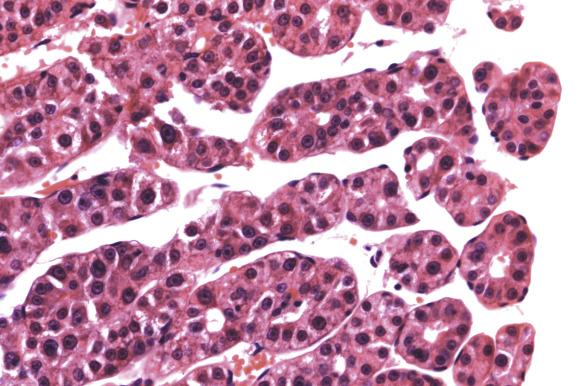
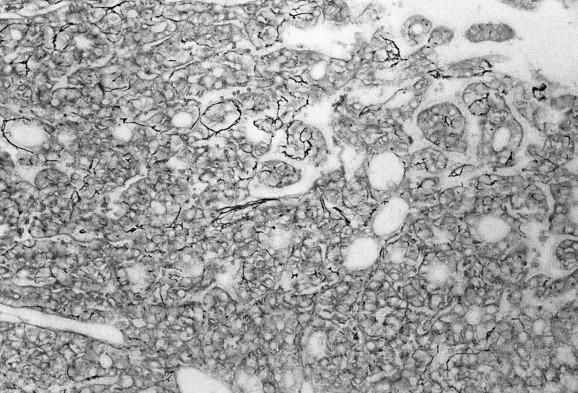
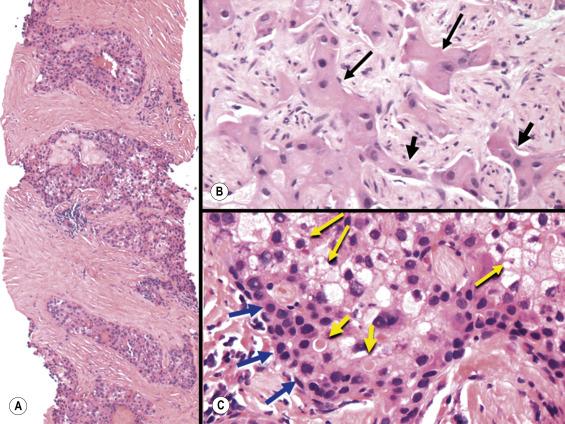
The so-called sclerosing carcinoma has been associated with hypercalcaemia but represents a poorly defined category in which some tumours may be of cholangiocyte origin. The adenoid (acinar) variant of HCC ( Fig. 11.18 ) should not be confused with adenocarcinoma of the biliary tree. Bile-duct carcinomas are usually scirrhous, mucin-secreting tumours, whereas the characteristic secretion of HCCs is bile, seen in a minority of tumours in spaces homologous with normal bile canaliculi. The large repertoire of histological features of HCC also includes the ‘steatohepatitic-HCC’ (SH-HCC) variant which recapitulates many of the features seen in benign steatohepatitis ( Fig. 11.19A ), the ‘lymphoepithelioma-like’ HCC ( Fig. 11.19B ) with admixed lymphocytes (predominantly T lymphocytes with fewer B cells) and variable association with Epstein–Barr virus and the ‘chromophobe HCC with abrupt anaplasia’ variant. Mixed or combined tumours designated combined hepatocellular–cholangiocarcinoma are also well described, with special stains and immunohistochemical features representative of both hepatocellular and bile-duct epithelial derivation. Progenitor/stem-cell constituents are sometimes present (discussed later).
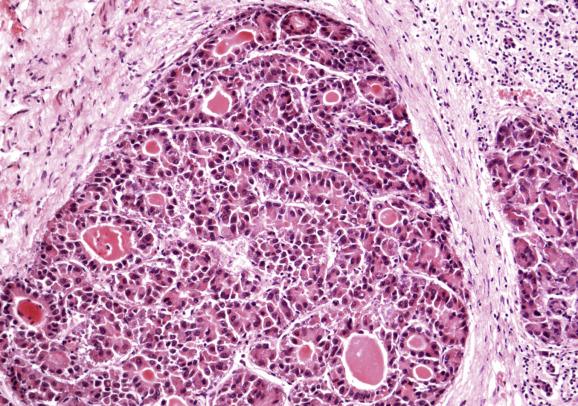

At a cellular level variants include giant-cell forms with multinucleated tumour cells (a bad prognostic sign ; Fig. 11.20 ), spindle-cell or sarcomatoid tumours and clear-cell carcinomas. The last must be distinguished from metastatic renal adenocarcinoma and PAX-8 immunostain nuclear positivity is helpful evidence of the latter. Fine-needle aspiration yields diagnostic material in a high proportion of patients. Histological grading of HCC from 1 to 4 is based on nuclear features, with grade 1 HCC resembling normal hepatocytes and grade 2 showing prominent nucleoli, hyperchromatism and nuclear membrane irregularities. Grades 3 and 4 show progressively greater nuclear pleomorphism, the latter featuring anaplastic and giant tumour cells ( Fig. 11.20 ). The World Health Organisation (WHO) incorporates the growth pattern as well as the cytologic nuclear features into the grading distinctions between well-differentiated (thin trabeculae), moderately differentiated (thick trabeculae) and poorly differentiated (sheet-like) HCCs. The grade of differentiation has significant prognostic implications. An example is the moderately differentiated HCC termed macrotrabecular-massive (trabeculae composed of >6 neoplastic hepatocytes) which has a more aggressive course, possibly because of enhanced angiogenesis resulting from overexpression of Ang2 (angiopoietin 2) and VEGF (vascular endothelial growth factor) A.
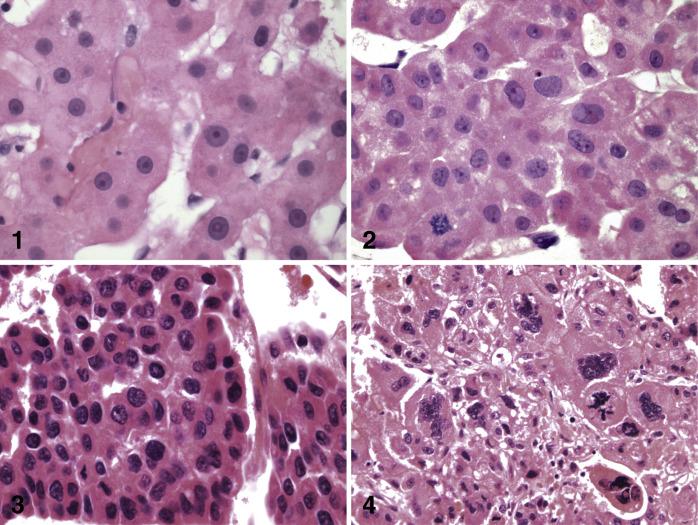
When there is doubt about the hepatocellular origin of a carcinoma, further evidence can sometimes be gained from the characteristics of the tumour cells. In HCC these often contain fat and glycogen, and may also contain α 1 -antitrypsin globules, even in patients without genetic α 1 -antitrypsin deficiency. Mallory–Denk bodies may be found in the cytoplasm of the tumour cells, particularly in the SH-HCC variant. In those cases due to chronic hepatitis B, sometimes the hepatitis B core and surface antigens are demonstrable immunohistochemically in neoplastic cells. Evidence of hepatocellular origin is also provided when immunohistochemical stains of paraffin sections are positive for albumin, fibrinogen, liver-cell cytokeratins (8 and 18), α 1 -antitrypsin or α 1 -antichymotrypsin.
There are several possible immunohistochemical strategies for confirming the diagnosis of HCC ( Fig. 11.21 and Table 11.4 ). A useful approach is to begin with the quartet of cytokeratin 7, cytokeratin 20, arginase-1 (and/or Hep Par 1 (hepatocyte)) and bile-salt export pump (BSEP). HCC typically is negative for both cytokeratin 7 and cytokeratin 20, while arginase-1 and Hep Par 1 stain normal and malignant hepatocytes (and, rarely, several extrahepatic tumours ). Hep Par 1 staining may be only patchy in needle biopsies of HCC or negative with more poorly differentiated tumours, liabilities which can be surmounted using other immunostains, such as the immunostain for BSEP, which has excellent specificity and sensitivity ( Fig. 11.22 ). With poorly differentiated HCC, BSEP positivity of canalicular/apical structures may be very focal, which emphasizes the need for extra diligence by the pathologist in reviewing this immunostain in such cases. CD10 and polyclonal carcinoembryonic antigen (pCEA) show similar results to BSEP but are less sensitive. Alpha-fetoprotein is an unreliable immunostain for HCC, in contrast to hepatoblastoma, where most cases stain positively. Arginase-1 immunostain has the highest sensitivity for HCC. It should be kept in mind, however, that in a recent study as many as 10% of well-differentiated HCCs showed negative staining for arginase-1; such cases rely on other appropriate immunostains as well as routine morphology (such as bile production by the tumour) for a definitive diagnosis. The immunostain for thyroid transcription factor-1, often used in the diagnosis of lung carcinomas, showed positive cytoplasmic (not nuclear) staining in the majority of HCCs in one study, which may be helpful in specific diagnostic settings.
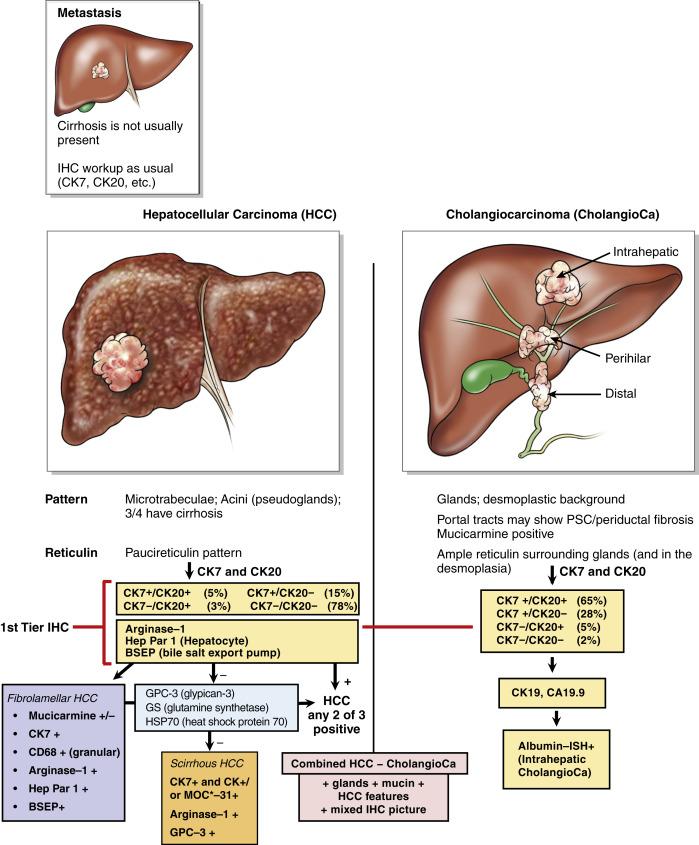
| Tumour | Recommended immunostain(s) |
|---|---|
| Hepatocellular carcinoma | Arginase-1 Hep Par 1 (hepatocyte) Bile-salt export pump (BSEP) ∗ Cytokeratin 7/20 pair (–/– staining) † GPC-3/GS/HSP70 trio ‡ |
| Hepatoblastoma | α-Fetoprotein (AFP) Hep Par 1 (hepatocyte) Polyclonal carcinoembryonic antigen |
| Cholangiocarcinoma | Cytokeratin 7/19 pair (+/+ staining) Cytokeratin 7/20 pair (+/+ staining) † Carbohydrate antigen 19-9 (CA19-9) |
| Angiomyolipoma | HMB-45 |
| Epithelioid | CD34 |
| Haemangioendothelioma | CD31 Factor VIII |
| Metastatic carcinoma | |
| Neuroendocrine | Chromogranin Synaptophysin Neuron-specific enolase |
| Pancreas | Cytokeratin 7/20 pair (+/+ staining) † |
| Colorectal | Cytokeratin 7/20 pair (–/+ staining) † |
| Breast | Cytokeratin 7/20 pair (+/– staining) † |
| Lung (non-small cell) | Cytokeratin 7/20 pair (+/– staining) † |
∗ Staining is canalicular or apical.
‡ HSP70, heat shock protein 70; GPC-3, glypican-3; GS, glutamine synthetase. At least two of the three should be positive (see reference 252).
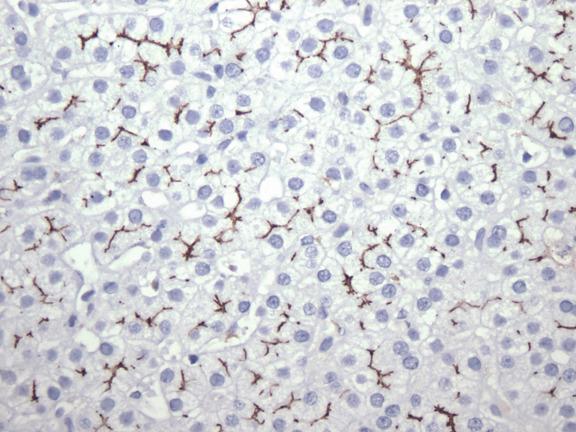
The trio of GPC-3, GS and heat shock protein 70 immunostains is another valuable combination for the diagnosis of HCC, particularly when any two of the three are positive. GPC-3, a cell-surface heparan sulphate proteoglycan, usually shows cytoplasmic positivity in the tumour cells, but may also be membranous or canalicular. It has particular value in staining poorly differentiated HCCs that are negative with Hep Par 1 and/or arginase-1, and is also applicable to fine-needle aspiration specimens. In hepatitis C-related cirrhosis, nodules with high-grade necroinflammatory activity have been noted to show strong GPC-3 positivity. Positive GPC-3 staining may also be seen in certain germ cell tumours, ovarian clear-cell carcinoma, squamous cell carcinoma of the lung, some gastrointestinal tract carcinomas and acinar pancreatic carcinoma. GS staining in non-neoplastic liver is restricted to the cytoplasm of perivenular hepatocytes, while HCC shows diffuse strong lesional staining. Heat shock protein 70 shows focal nucleocytoplasmic positivity in HCC. This panel of three immunostains also helps distinguish dysplastic lesions from HCC.
Certain tumours show mixed features of both hepatocellular and cholangiocytic differentiation or are phenotypically “intermediate” or “stem/progenitor” in appearance. A recent international consensus report provides guidelines for these complex cases. “Stemness” or progenitor/stem-cell features can be further evaluated with hepatic progenitor/stem-cell immunohistochemical markers, including neural cell adhesion molecule (NCAM), epithelial cell adhesion molecule (EpCAM), cytokeratin 7 (CK7) and CK19, c-KIT (CD117) and CD133. CK19 positivity has been associated with HCC invasiveness.
Become a Clinical Tree membership for Full access and enjoy Unlimited articles
If you are a member. Log in here